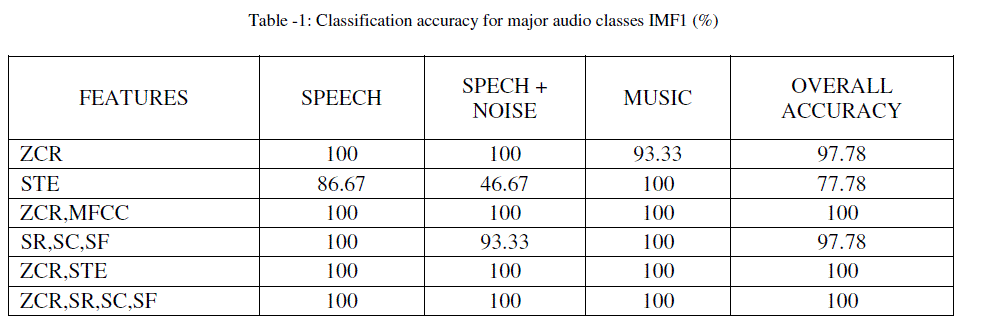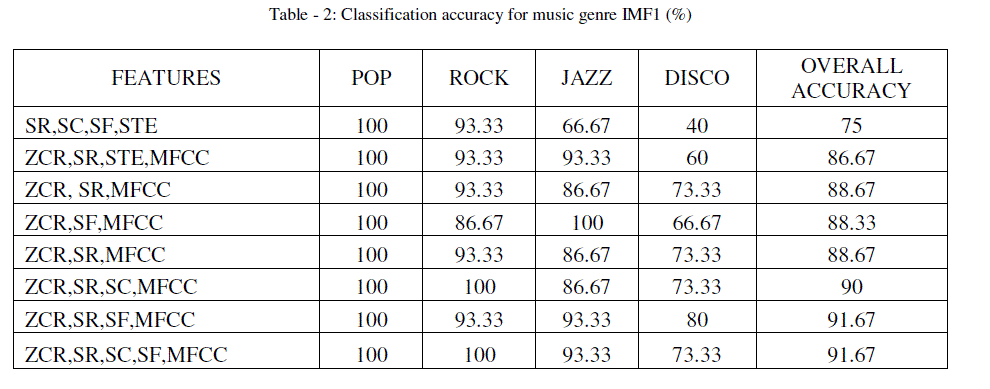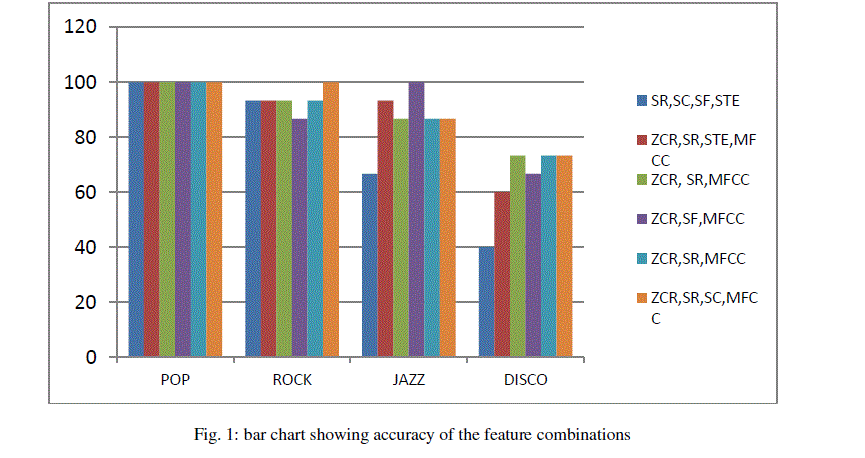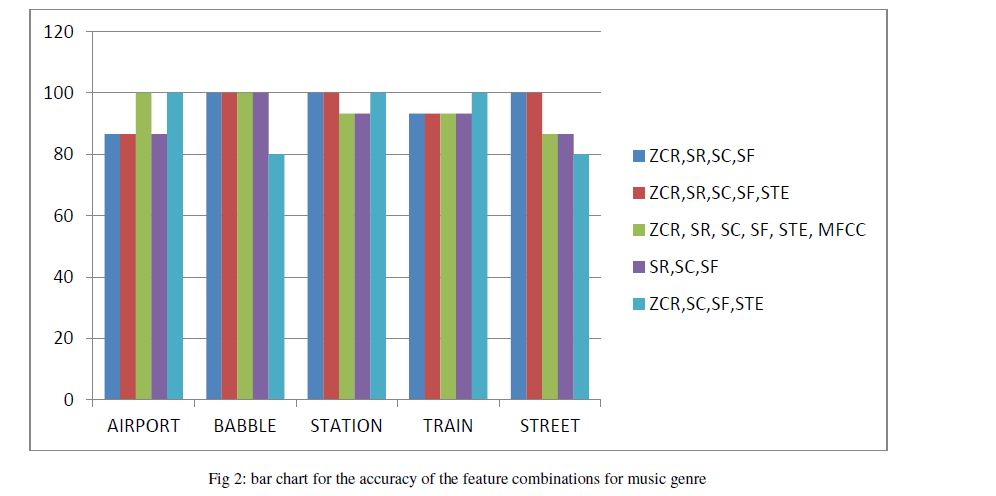ISSN ONLINE(2319-8753)PRINT(2347-6710)
ISSN ONLINE(2319-8753)PRINT(2347-6710)
Mr. Vinayak D. Chavan1, Dr. Sanjay L. Nalbalwar2
|
| Related article at Pubmed, Scholar Google |
Visit for more related articles at International Journal of Innovative Research in Science, Engineering and Technology
Audio classification is a process of assigning particular class to an audio signal. Classifying the audio signal has many applications in the field of digital library, automatic organization of databases etc. In the last several years efforts have been made to develop different methods to extract information from audio signals, so that they may be stored, organized and retrieved automatically whenever required. In this work, audio signals are classified into different categories based on spectral and temporal features. In this methodology, the audio signal is initially decomposed into overlapped frames. Ensemble Empirical Mode Decomposition (EEMD), which is noise assisted data analysis method, is used to convert these frames into a set of band-limited functions known as Intrinsic Mode Functions (IMFs). Temporal and Spectral features then extracted from these IMFs and thereafter classification is done using Gaussian Mixture Model (GMM) classifier. Different combinations of features were tested to create feature vector. The experimental results showed accuracy of more than 80%.
Keywords |
| Intrinsic mode function, ensemble empirical mode decomposition, spectral and temporal features, Gaussian Mixture Model. |
INTRODUCTION |
| In the past decade a huge amount of multimedia data in the form of text, images, audio and video has become available. With the increasing use of such audio data and challenges faced in different multimedia application, it has become essential to put effort into audio signal analysis. An audio signal classification system should be able to categorize different audio input formats. Particularly, detecting the audio type of a signal (clean speech, speech with environmental background noise, and speech with music) allows such new applications as automatic organization of audio databases, segmentation of audio streams, intelligent signal analysis, intelligent audio coding, automatic bandwidth allocation, automatic equalization, automatic control of sound dynamics etc. All classification systems employ the extraction of a set of features from the input signal. In our method the features are extracted from the signal such that their discrimination capability is increased. |
| We organize the remainder of this paper as follows: Section 2 gives related work in this field. The proposed methodology is presented in section 3 where we have described the EMD and EEMD techniques. Section 4 describes the commonly used features for classification and the basic concepts of Gaussian mixture model classifier. The database used for the experiments and experimental results is presented in Section 5. We conclude in Section 6 with conclusions and future work in the field. |
II. RELATED WORK |
| The five audio classes: silence, speech, music, speech with music and speech with noise is classified using feature extraction matrix in [1]. The classification of traffic noise sources: motorbikes, cars and heavy trucks are made in [2] by using spectral features like spectral centroid, spectral roll-off, sub-band energy ratio and zero-crossing rate as temporal feature. In [3] four types of background noise sources are classified using empirical mode decomposition method with accuracy up to 80-85%. Speech and music signals were classified using EMD in [7] with 85-90% accuracy. Three feature sets for representing timbral texture, rhythmic content and pitch content of music signals were proposed and evaluated using statistical pattern recognition classifiers with 61% accuracy in [9] for classifying ten musical genres. |
| In this paper, we have proposed a method for audio type identification as clean speech, speech with noise and music which relies on temporal and spectral shape features. Noisy speech is again classified into five subcategories as airport, babble, station, train and street [3], [4]. Also music is again classified as rock, pop, jazz, and disco. In this experiment, the input signal is hierarchically decomposed by ensemble empirical mode decomposition (EEMD) [6], [7]. A given signal is decomposed into a number of Intrinsic Mode Functions (IMFs) and a residual. The features are computed from IMFs and the residue. The performance of various features extracted from the IMFs is evaluated using Gaussian mixture model classifier. |
III. PROPOSED METHODOLOGY |
| 2.1 Empirical Mode Decomposition |
| Empirical Mode Decomposition (EMD) is one of the methods of feature extraction. It is advantageous compared to the other methods as EMD is an adaptive data analysis method that is based on local characteristics of the data, and hence, it catches nonlinear, non-stationary oscillations more effectively. EMD method is able to decompose a complex signal into a series of intrinsic mode functions (IMF) and a residue. [6], [7]. |
| 2.1.1 Intrinsic Mode Function |
| The EMD decomposes the original signal into a definable set of adaptive basis of functions called the intrinsic mode functions. Each IMF must satisfy two basic conditions: In the whole data set, the number of local minima or local maxima and the number of zero crossings must be equal or they may differ at most by one. At any point, the mean value of the envelope, one defined by the upper envelope and the other by the lower envelope is zero. To generate the IMFs sifting process is applied. The signal is decomposed until we get the final component as residue. |
| 1. identify all extrema of x(t). |
| 2. Interpolate the local maxima to form an upper envelope u(t). |
| 3. Interpolate the local minima to form an lower envelope l(t). |
| 4. Calculate the mean envelope: m(t)=[u(t)+l(t)]/2. |
| 5. Extract the mean from the signal: h(t)=x(t)-m(t) |
| 6. if h(t) satisfies the IMF Condition, stop sifting else keep sifting. |
| 2.2 Ensemble Empirical Mode Decomposition |
| EMD is a dyadic filter bank for any white noise-only series, when the data is intermittent; the dyadic property is often compromised. Hence, adding noise to the data could provide a uniformly distributed reference scale. This enables EMD to repair the compromised dyadic property; and the corresponding IMFs of different series of noise have no correlation with each other. Therefore, the means of the corresponding IMFs of different white noise series are likely to cancel each other [8]. With these properties of the EMD in mind, the EEMD is developed as follows: |
| 1. Add a white noise series to the targeted data. |
| 2. Decompose the data with added white noise into IMFs. |
| 3. Repeat step 1 and step 2 again and again, but with different white noise series each time. |
| 4. Obtain the (ensemble) means of corresponding IMFs of the decompositions as the final result. |
IV. FEATURE EXTRACTION AND CLASSIFICATION |
| Features extraction is the main step for classifying any audio signal into a given class [5]. These features will decide the class of the signal. Feature extraction involves the analysis of the input signal. The feature extraction techniques can be classified as temporal analysis and spectral analysis technique. Temporal analysis uses the waveform of the audio signal itself for analysis. Temporal features include Short Time Autocorrelation Function (ACF), Short Time Energy (STE), and Zero Crossing Rate (ZCR). Spectral analysis utilizes spectral representation of the music signal for analysis. Spectral features include Spectral Centroid (SC), Spectral Roll off (SR) and Spectral Flux (SF) [9]. Using these features, feature vector is formed which is then applied to the classifier for classification. In our experiment we used Gaussian Mixture Model classifier with Maximum Likelihood. |
| 3.1 Gaussian Mixture Models (GMM) |
| GMMs model the distribution of feature vectors. For each class, we assume the existence of a probability density function expressible as a mixture of a number of multidimensional Gaussian distributions. The iterative Expectation Maximization (EM) algorithm is usually used to estimate the parameters for each Gaussian component and the mixture weights. GMMs have been widely used as classifiers by using a maximum likelihood criterion to find the model best suited to a particular audio [6]. |
V. EXPERIMENTS AND RESULTS |
| In out experiment, we have classified audio signal into three major classes: clean speech, speech with background noise and music. Then the noisy speech signal is again classified into five sub-categories: airport, babble, station, train and street. Music signal is classified into four sub-categories: pop, rock, jazz and disco. For this experiment we selected dataset consisting of 30 clean speech signals, 150 noisy speech signals and 120 music signals of 2-5 sec duration long. The noisy speech consists of one type of noise mixed with speech with different utterances. The given signal is first segmented into frames of 50 ms duration and 25 ms overlap between each frame. Then each frame is decomposed into IMFs using Ensemble Empirical Mode Decomposition. These IMFs are then used for extracting different features as mentioned in section 3. If there is ‘N’ no. of frames for one signal then mean of particular feature of all the frames is considered as one of the feature for that signal. |
| where ‘r’ denotes feature no. and ‘i’ denotes the frame no. of one particular signal. From these features we formed the feature vector which is then applied for classification. |
| Where ‘v’ is signal no., ‘m’ in IMF no. and ‘r’ is feature no. Feature vectors are formed by combining different set of features for each audio category and then Classification is performed using GMM classifiers with Maximum Likelihood. Results of classification which are having very good accuracy are presented below. Others are not presented as the accuracy was not so good. |
 |
| From the above results it is clear that, individual features like ZCR, STE can discriminate between speech and music. All music samples are correctly identified. But between speech and speech with noise identification, the accuracy is quite less. So, different feature combinations were tested and observed that the accuracy up to 100% can be achieved. |
 |
 |
| Music signals with different genre are highly similar. Hence, individual features are not sufficient to classify all the genres. From above results, it is clearly observed that the obtained accuracy is up to 92% which is very good. |
 |
 |
| Noise signal classification is important in case speaker/speech recognition. As observed in table 3, background noise sources, with feature combinations, can be classified with more than 90% accuracy, which is very good. Also it is observed that first IMF can discriminate between the specified categories with good accuracy. Other IMFs also tested for classification but the accuracy is less than the accuracy of IMF1. Hence results for other IMFs are not mentioned. |
VI. CONCLUSION |
| Automatic audio classification is a complicated and problematic task, but still has important value both in research and commercialized applications. In this paper, we introduced use of EEMD for different types audio classification by decomposing the signals into no. of IMFs and extracting spectral and temporal features from these IMFs. The values of selected features are used to form feature vector by combining different features and then classification is done. Experimental results show that EEMD can be successfully used for different types of audio classification whether it is speech/music classification, environmental noise classification or music genre classification with accuracy more than 85%. For future work, different kinds of features can be extracted and various classifiers can also be used to improve the accuracy. Also audio signals of longer duration can be used to get more accurate classification.c |
References |
|